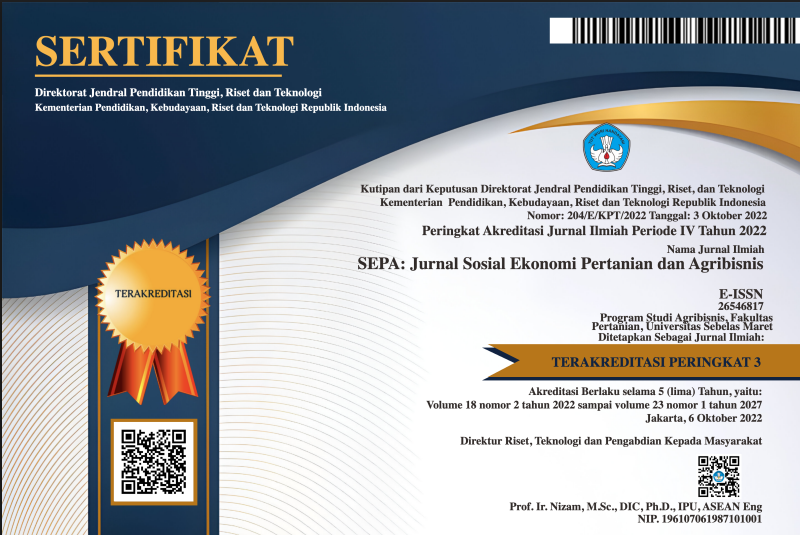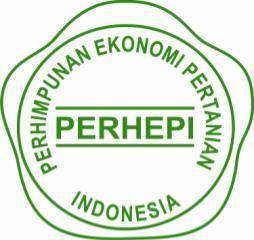ANALISIS POTENSI PENGEMBANGAN KOMODITAS JAGUNG DI WILAYAH PERBATASAN NKRI – PNG KABUPATEN KEEROM PAPUA
Abstract
Keywords
Full Text:
PDFReferences
Amar, K., dan Zakaria. 2011. “Kebijakan Antisipatif Dan Strategi Penggalangan Petani Menuju Swasembada Jagung Nasional.” Pulitbang Sosial Ekonomi Pertanian 15.
BPS 2017. Keerom Dalam Angka Tahun 2016. Badan Pusat Statistik Kabupaten Keerom.
BPS 2018. Keerom Dalam Angka Tahun 2017. Badan Pusat Statistik Kabupaten Keerom.
BPS 2019. Keerom Dalam Angka Tahun 2018. Badan Pusat Statistik Kabupaten Keerom.
BPTP Papua. 2014. Pewilayahaan Komoditas Pertanian Berdasarkan Zona Agroekologi Skala 1 : 50.000 Kabupaten Keerom Papua. Laporan Kegiatan Balai Pengkajian Teknologi Pertanian. Balai Besar P2TP. Balitbangtan.
Budianto, A. 2010. “Pengembangan Wilayah Perbatasan Sebagai Upaya Pemerataan Pembangunan Wilayah Di Indonesia.” Jurnal SMART 8:72–82.
Ditjen Tanaman Pangan, Kementan. 2010. RPJMN Bidang Pangan Dan Pertanian 2010-2014. Jakarta.
Hendayana, R. 2013. Aplikasi Metode Location Quotient (LQ) Dalam Penentuan Komoditas Unggulan Nasional. Bogor: Informatika Pertanian.
Kementan. 2013. “Data Statistik Ketahanan Pangan Tahun 2012.” BUKU.
Lewaherilla, N.E, S.Tirajoh dan M. Thamrin. 2019. Potensi Dan Arah Pengembangan Kawasan Pertanian Mendukung Lumbung Pangan Berorientasi Ekspor Di Wilayah Perbatasan Kabupaten Keerom. Bogor: IAARD Press.
Mulyono, J. dan H. Nugroho. 2019. Pewilayahan Dan Kelayakan Usahatani Jagung Kabupaten Bantul. Bogor: Balai Besar Pengkajian dan Pengembangan Teknologi Pertanian Kementan Tahun 2017.
Nedi, B., S. Supardi dan J. Sutrisno. 2014. “Analisa Usahatani Jagung Di Kabupaten Grobogan Jawa Tengah.” Agibisnis Riviuw.
Panikkai, S., R. Nurmalina, S. Mulatsih dan H. Purwati. 2017. Analisa Ketersediaan Jagung Nasional Menuju Pencapaian Swasembada Dengan Pendekatan Model Dinamik. Jakarta: Informatika Pertanian.
Rustiadi, E.S., S. Saefulhakim dan D. Panuju. 2011. Perencanaan Dan Pengembangan Wilayah. Jakarta: Cresoent Press dan Yayasan Obor Indonesia Jakarta.
Soekartawi. 1995. Analisis Usahatani. Jakarta: Penerbit Universitas Indonesia. Jakarta.
Soekartawi. 2006. Ilmu Usahatani. Penelitian Untuk Pengembangan. Jakarta: UI. Press. Jakarta.
DOI: https://doi.org/10.20961/sepa.v20i2.52339
Refbacks
- There are currently no refbacks.



.png)







.png)
3.png)





